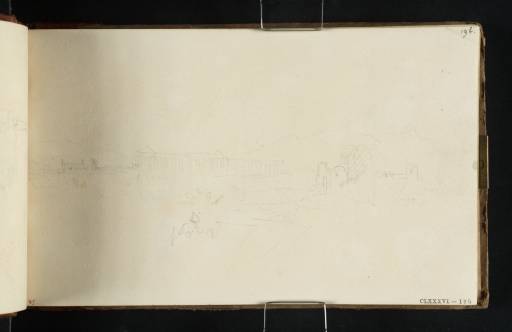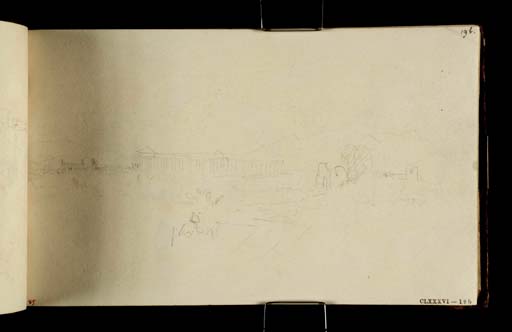Joseph Mallord William Turner The Three Temples at Paestum 1819
Image 1 of 2
Joseph Mallord William Turner,
The Three Temples at Paestum
1819
Joseph Mallord William Turner 1775–1851
Folio 20 Recto:
The Three Temples at Paestum 1819
D15946
Turner Bequest CLXXXVI 19 b
Turner Bequest CLXXXVI 19 b
Pencil on white wove paper, 113 x 189 mm
Inscribed by ?John Ruskin in red ink ‘245’ bottom left and by an unknown hand in black ink ‘19b’ top right
Stamped in black ‘CLXXXVI 19b’ bottom right
Stamped in black ‘CLXXXVI 19b’ bottom right
Accepted by the nation as part of the Turner Bequest 1856
References
1909
A.J. Finberg, A Complete Inventory of the Drawings of the Turner Bequest, London 1909, vol.I, p.551, as ‘Pæstum’.
1983
Cecilia Powell, ‘Turner’s Vignettes and the Making of Rogers’s “Italy”, Turner Studies, Summer 1983, vol.3, no.1, p.8.
1984
Cecilia Powell, ‘Turner on Classic Ground: His Visits to Central and Southern Italy and Related Paintings and Drawings’, unpublished Ph.D thesis, Courtauld Institute of Art, University of London 1984, pp.190 note 91, 425, 535–6 note 26, as ‘The three temples at Paestum (L to R: Ceres, Neptune, Basilica)’.
1987
Cecilia Powell, Turner in the South: Rome, Naples, Florence, New Haven and London 1987, p.83 note 71.
1993
Dr Jan Piggott, Turner’s Vignettes, exhibition catalogue, Tate Gallery, London 1993, p.82 under no.7.
The southernmost destination on Turner’s tour of Italy in 1819–20 was Paestum, an ancient city on the Tyrrhenian coast, approximately twenty miles south-east of Salerno. Here, like many British tourists, the artist visited the three famous fifth-century BC Greek Doric temples which stand on a plain between the mountains and the sea. Rediscovered in the mid-eighteenth century, the remains represented some of the most well preserved and complete temples in Europe, and according to Revd John Chetwode Eustace in A Classical Tour Through Italy (first published 1813), surpassed those in every other Italian city except Rome.1 Turner was already familiar with the appearance of the ruins through the work of other artists including Giovanni Battista Piranesi (1720–1778),2 John Robert Cozens (1752–1797),3 and John ‘Warwick’ Smith (1749–1831).4 Furthermore he had used an illustrated diagram featuring the so-called Temple of Neptune in his perspective lectures at the Royal Academy (see Tate D17072; Turner Bequest CXCV 102). Having made the journey from Naples to Paestum for himself he eagerly seized the opportunity to make a number of on-the-spot sketches, exploring the site from a variety of angles, see folios 19 verso, 31–33 verso, 44 verso–45 verso (D15945, D15968–D15973, D15995–D15997; Turner Bequest CLXXXVI 19a, 29–31a, 42a–43a).
This sketch represents a conventional view of the three temples seen from the south-west. In the distance on the left is the Temple of Athena (formerly known as the Temple of Ceres), whilst in the central middle distance are the two Temples dedicated to Hera. These were formerly (incorrectly) known as the Temple of Neptune (left) and the Basilica (right) but were reattributed in the twentieth century. The composition is virtually identical to that of a drawing by James Hakewill (1778–1843), Temples at Paestum 1816 (Library of the British School at Rome),5 engraved for the Picturesque Tour of Italy (published 1820), a project for which Turner had also contributed illustrations in 1819. It is extremely likely therefore that Turner would have seen Hakewill’s study prior to his own Italian tour.
The temples at Paestum formed the subject for one of Turner’s vignette illustrations for Rogers’s Italy (published 1830). The composition, however, appears to bear no relation to any of the on-the-spot sketches and is derived entirely from imagination and memory.6 For a more detailed discussion see the entry for the watercolour vignette (Tate D27665; Turner Bequest CCLXXX 148). Turner made a related design for the Little Liber (see Tate D36070; Turner Bequest CCCLXIV 224),7 and Powell has also suggested that there may be a visual reference to Paestum in the temples seen in the background of the later finished oil painting, Story of Apollo and Daphne, exhibited 1837 (Tate, N00520).8
Nicola Moorby
July 2010
John Chetwode Eustace, A Classical Tour Through Italy, London 1815, 3rd edition, vol.III, pp.76–108.
For example, The Two Temples at Paestum,1782 (Victoria and Albert Museum, London), reproduced in Giuliano Briganti, Nicola Spinosa and Lindsay Stainton, In the Shadow of Vesuvius: Views of Naples from Baroque to Romanticism 1631–1830, exhibition catalogue, Accademia Italiana delle Arti e dell arti Applicate, London 1990, p.70.
See Tony Cubberley and Luke Herrmann, Twilight of the Grand Tour: A catalogue of the drawings by James Hakewill in the British School at Rome Library, Rome 1992, no.5.58, reproduced p.290.
See also W.G. Rawlinson, The Engraved Work of J.M.W. Turner, R.A., London 1908, vol.II, no.799 (Tate, T04914).
How to cite
Nicola Moorby, ‘The Three Temples at Paestum 1819 by Joseph Mallord William Turner’, catalogue entry, July 2010, in David Blayney Brown (ed.), J.M.W. Turner: Sketchbooks, Drawings and Watercolours, Tate Research Publication, December 2012, https://www


